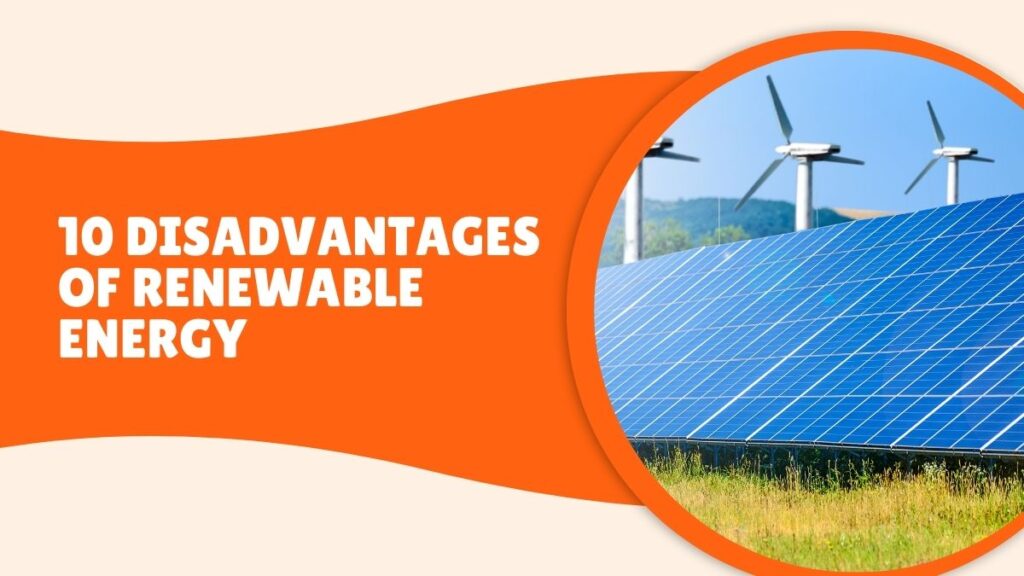Renewable energy is a great way to make the world cleaner. It helps reduce pollution and fight climate change. But it’s not perfect.
There are challenges that make it harder to switch. It can be expensive, the technology isn’t always reliable, and sometimes it even affects nature in unexpected ways. Right now, about 30% of the world’s electricity comes from renewable sources. That’s progress, but there’s still a long way to go.
This article looks at 10 disadvantages of renewable energy. Not to say it’s bad, but to understand the problems so we can find better solutions.
10 Disadvantages of Renewable Energy PDF
10 Disadvantages of Renewable Energy
Think renewable energy is the perfect solution? Think again. Discover the 10 disadvantages of renewable energy that challenge its growth and effectiveness.
Disadvantage 1: Intermittency and Reliability Issues
Struggling with intermittency and reliability issues? Find out how the unpredictable nature of renewable energy sources like wind and solar can affect their effectiveness.
Unpredictable Output
Solar and wind energy depend on the weather. Solar panels don’t work at night, and cloudy days make them less effective. Wind turbines need just the right wind—too little or too much, and they stop working.
Because of this, the energy supply isn’t always steady. If solar and wind power suddenly drop, there might not be enough electricity when people need it.
Backup and Storage Needs
To keep power available at all times, extra energy needs to be stored. Batteries can help, but they’re expensive and don’t store unlimited energy.
Another option is backup power from things like natural gas or hydropower. But that costs more and takes away some of the environmental benefits of renewable energy.
Disadvantage 2: High Upfront Costs and Economic Barriers
Concerned about the high upfront costs and economic barriers? Learn how the expensive initial investment in renewable energy can slow down its widespread adoption.
Expensive to Set Up
Solar panels, wind turbines, and other renewable systems cost a lot to install. The equipment and setup can be pricey.
It also takes a long time to make back the money spent. Fossil fuels are often cheaper to start with and give quicker returns.
Hard for People to Afford
Because of the high cost, many homeowners, small businesses, and even governments find it hard to switch to renewable energy.
Even though it can save money over time, the big upfront cost makes it difficult for many people to get started.
Disadvantage 3: Land and Space Problems
Running out of space for renewable energy? Land and space problems can limit the potential of solar and wind power. Discover how these challenges impact clean energy growth.
Takes Up a Lot of Space
Renewable energy needs a lot of land. Solar farms cover big areas to get enough sunlight. Wind farms need lots of space so turbines aren’t too close together. Hydropower, like dams, takes up even more land because it floods valleys to store water.
Traditional power plants, like coal and gas, make more electricity in a smaller space. A coal plant can produce as much power on a few hundred acres as a solar farm that spreads over thousands.
Effects on Nature and People
Using so much land can harm the environment. Solar farms take over fields and forests. Wind turbines can be dangerous for birds and bats. Dams change rivers and make it harder for fish to swim.
There can also be problems with land use. Some projects take land that could be used for farms, homes, or wildlife. In some cases, people are forced to move. Clean energy is important, but it’s also important to protect nature and people’s way of life.
Disadvantage 4: Energy Storage Problems
“Facing energy storage problems? Learn how storing renewable energy for later use remains a significant challenge in making clean energy more reliable and efficient.
Limits of Today’s Batteries
Storing energy is hard. Batteries can only hold so much power, don’t last forever, and are very expensive. Over time, they wear out and don’t work as well.
Other storage methods exist, like pumped hydro, which stores water at a high place and releases it to make electricity. But this only works in certain locations. Other methods, like storing air or heat, also have limits and are not common.
High Costs and Challenges
Building storage systems costs a lot of money and takes time. Batteries need big storage facilities. Pumped hydro needs dams and reservoirs. Power grids also need upgrades to handle stored energy.
Without good storage, renewable energy can be unreliable. The sun isn’t always shining, and the wind isn’t always blowing. To make clean energy work better, storage needs to improve, but that takes big investments.
Disadvantage 5: Grid Integration and Upgrades
Struggling with grid integration and upgrades? Find out how connecting renewable energy to existing power grids can be more complicated than you might think.
Updating the Power Grid
Most power grids were built for steady energy from coal and gas. But solar and wind energy depend on the weather and come from many places, not just a few big power plants. The grid needs upgrades to handle these changes.
It’s also harder to keep the power steady. If the sun goes behind clouds or the wind stops, energy levels can change fast. Without upgrades, this can cause power shortages or overloads.
High Costs and Challenges
Upgrading the grid is expensive. It takes new technology, better storage, and stronger power lines. These changes take time and money, making it a big challenge for using more renewable energy.
Disadvantage 6: Material Shortages and Sustainability Issues
Did you know material shortages and sustainability issues threaten the future of renewable energy? Discover how limited resources can hinder the growth of clean energy solutions.
Dependence on Rare Materials
Solar panels, wind turbines, and batteries need special materials like lithium, cobalt, and rare earth elements. These materials are not easy to find, and mining them is expensive and difficult.
Most of these materials come from only a few countries. This can cause shortages, higher prices, or delays if there are trade or political problems.
Sustainability and Ethical Concerns
These materials are limited, so relying on them too much could cause problems in the future. If demand keeps growing, there may not be enough.
Mining can also harm the environment, and in some places, workers face unsafe conditions. Some mines even use child labor. While renewable energy is better for the planet, finding fair and sustainable ways to get materials is important.
Disadvantage 7: Environmental Impact of Manufacturing and Waste
While renewable energy is cleaner, the environmental impact of manufacturing and waste can’t be ignored. Learn how producing green energy can still harm the environment in unexpected ways.
Pollution from Production
Making solar panels, wind turbines, and batteries creates pollution. Factories use a lot of energy and water and can release harmful chemicals. Mining for the materials also hurts nature.
Producing this equipment takes many resources, and the process adds to pollution.
Recycling and Waste Problems
Old solar panels and wind turbines are hard to recycle. Many parts cannot be reused and end up in landfills.
Without better recycling methods, waste from renewable energy can pile up over time. We need to find ways to reuse materials to protect nature.
Disadvantage 8: Geographical and Climatic Limitations
Did you know geographical and climatic limitations can affect renewable energy? Discover how location and weather patterns impact the effectiveness of clean energy sources.
Regional Suitability
Not all places are good for renewable energy. Some areas don’t get enough sun for solar panels, others don’t have strong winds for wind turbines, and some lack the water needed for hydropower.
Weather also affects energy production. Cloudy days reduce solar power, and calm days limit wind energy. If the weather changes too much, energy supply can be unreliable.
Diverse Energy Needs
Because every place is different, one type of renewable energy may not work everywhere. A mix of energy sources is needed to keep power steady.
Using different types of energy helps make sure there is always enough power, no matter the weather or location.
Disadvantage 9: Policy, Regulation, and Public Acceptance Challenges
Facing hurdles with policy, regulation, and public acceptance? Learn how these challenges can slow down the progress of renewable energy adoption and what it means for the future.
Policy and Regulation Barriers
Renewable energy needs good policies to grow, but many rules are outdated or unclear. This makes it harder to expand.
Most energy rules were made for coal and gas. Changing them to support renewables takes time and slows progress.
Social and Public Acceptance Issues
Some people don’t like renewable energy projects. Wind turbines can be noisy and change the way places look. Some also believe false information about renewables.
In areas that rely on coal or gas jobs, switching to renewables can cause job losses. Without support, this change can be hard for workers and communities.
Disadvantage 10: Geopolitical and Supply Chain Risks
Did you know renewable energy comes with geopolitical and supply chain risks? Discover how these factors can impact the stability and growth of clean energy solutions.
Global Supply Chain Vulnerabilities
Renewable energy depends on materials like lithium and rare earth metals, which come from a few countries. This creates risks if supplies are delayed or prices go up.
Trade issues and political tensions can make it harder to get these materials. If one country limits exports, it can slow down renewable energy projects worldwide.
Economic and Security Implications
If supplies are uncertain, renewable energy systems can become less stable and reliable. High prices or shortages can slow progress and make energy more expensive.
To avoid these problems, countries need better ways to source materials and reduce dependence on just a few suppliers.
Conclusion
While renewable energy offers many benefits, it also comes with its own set of challenges. Understanding the 10 disadvantages of renewable energy helps us find better solutions for a cleaner future.
Recap of Disadvantages
Renewable energy is helpful, but it has problems. It can be unreliable, expensive, take up land, and be hard to store. The grid needs upgrades, materials can be scarce, and making renewable energy parts can harm the environment. Some places don’t get enough sun or wind, and rules and supply issues can slow progress.
To make it work better, these problems need to be solved.
Future Outlook and Call to Action
We need better technology, good policies, and smart investments. Research and new ideas can make renewable energy more reliable and affordable.
Everyone—governments, businesses, and people—can help. If we work together, we can build a better energy future.
“Sustainability isn’t just about replacing fossil fuels—it’s about building systems that last.”



